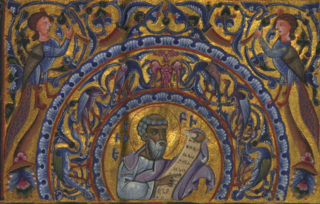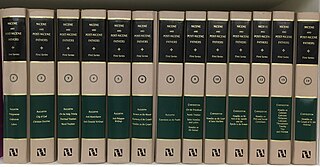Gelasius of Cyzicus was an ecclesiastical writer in the 5th century. The often attributed name Gelasius is an error of Photius I of Constantinople and of the editor of the editio princeps ; the anonymous author never mentioned his name. [1]
The author tells us that he was the son of a priest of Cyzicus, and that he wrote in the Roman province of Bithynia in Asia Minor, about 475, to prove against the Eutychians, that the Nicene Fathers did not teach Monophysitism. These details he gives us in his preface. [2] Beyond that nothing is known about him.
His "Syntagma" or collection of Acts of the First Nicene Council has hitherto been looked upon as the work of a sorry compiler; recent investigations, however, point to its being of some importance. It is divided into three books: [3] book I treats of the Life of Constantine down to 323; book II of History of the Council in thirty-six chapters; of book III only fragments were originally published, until the whole of book III was discovered by Cardinal Mai in the Ambrosian Library.
The serious study of the sources of Gelasius may be said to have begun with Turner's identification of the long passages taken from Rufinus [4] in book II. A complete analysis of the sources [5] was done by Gerhard Löscheke, whose efforts restored to Gelasius a place among serious Church historians, of which he has been wrongly deprived and have also lent weight to the hitherto generally rejected idea that there was an official record of the Acts of the Council of Nicaea; and further that it was from this record that Dalmatius derived the opening discourse of Constantine, the confession of Hosius, the dialogue with Phaedo, and the nine dogmatic constitutions, which Hefele had pronounced "most certainly spurious".
The "John" to whom Gelasius refers, as a forerunner of Theodoret, is still unidentified; from him were derived the published portions of book III, the letters of Constantine to Arius, to the Church of Nicomedia and to Theodotus, all of which Löschcke contends are authentic. He also proves that a comparison of Constantine's letter to the Synod of Tyre (335), as given by Gelasius and Athanasius, [6] shows Gelasius to give the original, Athanasius an abbreviated version.

Flavius Julius Constans, also called Constans I, was Roman emperor from 337 to 350. He held the imperial rank of caesar from 333, and was the youngest son of Constantine the Great.

Eusebius of Caesarea, also known as Eusebius Pamphilus, was a Greek Syro-Palestinian historian of Christianity, exegete, and Christian polemicist. In about AD 314 he became the bishop of Caesarea Maritima in the Roman province of Syria Palaestina. Together with Pamphilus, he was a scholar of the biblical canon and is regarded as one of the most learned Christians during late antiquity. He wrote Demonstrations of the Gospel, Preparations for the Gospel and On Discrepancies between the Gospels, studies of the biblical text. As "Father of Church History", he produced the Ecclesiastical History, On the Life of Pamphilus, the Chronicle and On the Martyrs. He also produced a biographical work on Constantine the Great, the first Christian Roman emperor, who was Augustus between AD 306 and AD 337.
Eusebius of Nicomedia was an Arian priest who baptized Constantine the Great on his deathbed in 337. A fifth-century legend evolved that Pope Sylvester I was the one to baptize Constantine, but this is dismissed by scholars as a forgery 'to amend the historical memory of the Arian baptism that the emperor received at the end of his life, and instead to attribute an unequivocally orthodox baptism to him.' He was a bishop of Berytus in Phoenicia. He was later made the bishop of Nicomedia, where the Imperial court resided. He lived finally in Constantinople from 338 up to his death.

The First Council of Nicaea was a council of Christian bishops convened in the Bithynian city of Nicaea by the Roman Emperor Constantine I. The Council of Nicaea met from May until the end of July 325.

The First Council of Constantinople was a council of Christian bishops convened in Constantinople in AD 381 by the Roman Emperor Theodosius I. This second ecumenical council, an effort to attain consensus in the church through an assembly representing all of Christendom, except for the Western Church, confirmed the Nicene Creed, expanding the doctrine thereof to produce the Niceno-Constantinopolitan Creed, and dealt with sundry other matters. It met from May to July 381 in the Church of Hagia Irene and was affirmed as ecumenical in 451 at the Council of Chalcedon.
The 330s decade ran from January 1, 330, to December 31, 339.

A Select Library of the Nicene and Post-Nicene Fathers of the Christian Church, usually known as the Nicene and Post-Nicene Fathers (NPNF), is a set of books containing translations of early Christian writings into English. It was published between 1886 and 1900.

Theodoret of Cyrus or Cyrrhus was an influential theologian of the School of Antioch, biblical commentator, and Christian bishop of Cyrrhus (423–457). He played a pivotal role in several 5th-century Byzantine Church controversies that led to various ecumenical acts and schisms. He wrote against Cyril of Alexandria's 12 Anathemas which were sent to Nestorius and did not personally condemn Nestorius until the Council of Chalcedon. His writings against Cyril were included in the Three Chapters Controversy and were condemned at the Second Council of Constantinople. Some Chalcedonian and East Syriac Christians regard him as blessed.
Socrates of Constantinople, also known as Socrates Scholasticus, was a 5th-century Greek Christian church historian, a contemporary of Sozomen and Theodoret.

Didymus the Blind was a Christian theologian in the Church of Alexandria, where he taught for about half a century. He was a student of Origen, and, after the Second Council of Constantinople condemned Origen, Didymus's works were not copied. Many of his writings are lost, but some of his commentaries and essays survive. He was seen as intelligent and a good teacher.

Arius was a Cyrenaic presbyter, ascetic, and priest. Traditionally, it was claimed that Arius was the founder of the doctrine of Arianism but, more recently, Rowan Williams stated that "Arius' role in 'Arianism' was not that of the founder of a sect. It was not his individual teaching that dominated the mid-century eastern Church."

Macarius I ; was Bishop of Jerusalem from 312 to shortly before 335, according to Sozomen. He is recognized as a saint within the Orthodox and Catholic churches.
Salamanes Hermias Sozomenos, also known as Sozomen, was a Roman lawyer and historian of the Christian Church.
The Patrologia Graeca is an edited collection of writings by the Christian Church Fathers and various secular writers, in the Greek language. It consists of 161 volumes produced in 1857–1866 by J.P. Migne's Imprimerie Catholique, Paris.
The Arian controversy was a series of Christian disputes about the nature of Christ that began with a dispute between Arius and Athanasius of Alexandria, two Christian theologians from Alexandria, Egypt. The most important of these controversies concerned the relationship between the substance of God the Father and the substance of His Son.
The Pneumatomachi, also known as Macedonians or Semi-Arians in Constantinople and the Tropici in Alexandria, were an anti-Nicene Creed sect which flourished in the regions adjacent to the Hellespont during the latter half of the fourth, and the beginning of the fifth centuries. They denied the godhood of the Holy Ghost, hence the Greek name Pneumatomachi or 'Combators against the Spirit'.

The Church History of Eusebius, the bishop of Caesarea, was a 4th-century pioneer work giving a chronological account of the development of Early Christianity from the 1st century to the 4th century. It was written in Koine Greek, and survives also in Latin, Syriac and Armenian manuscripts.

Gelasius of Caesarea was bishop of Caesarea Maritima from 367 to 373 and from 379 to his death. He was also an author, though none of his work survives.
Patrophilus was the Arian bishop of Scythopolis in the early-mid 4th century AD. He was an enemy of Athanasius who described him as a πνευματόμαχος or "fighter against the Holy Spirit". When Arius was exiled to Palestine in 323 AD, Patrophilus warmly welcomed him.
Theodotus was the bishop of Laodicea in Syria from the early 300s. He replaced Stephen, who apostasized during the Great Persecution (303–313). The exact year of his consecration cannot be fixed more precisely. He attended at least four church councils.
 This article incorporates text from a publication now in the public domain : Herbermann, Charles, ed. (1913). "Gelasius of Cyzicus". Catholic Encyclopedia . New York: Robert Appleton Company.
This article incorporates text from a publication now in the public domain : Herbermann, Charles, ed. (1913). "Gelasius of Cyzicus". Catholic Encyclopedia . New York: Robert Appleton Company.









